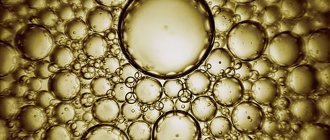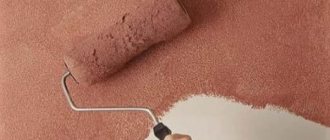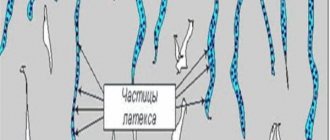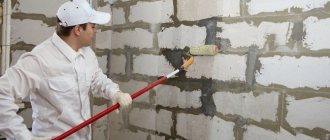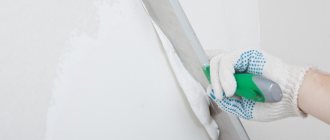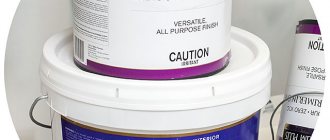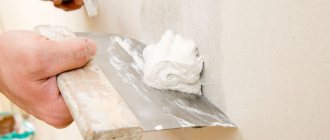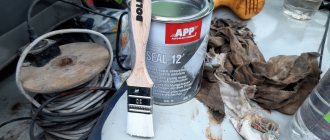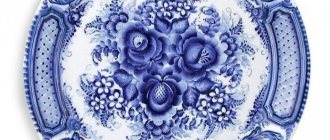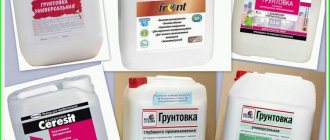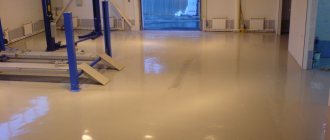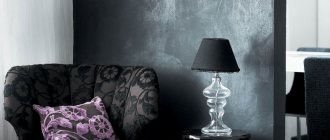Savig
4114 0 0
Savig June 12, 2017Specialization: master of interior finishing works. I am well versed in power tools for repair and construction. Formerly a teacher at a radio engineering college.
Water-dispersion putty is used to eliminate defects and partially level the surfaces of various building materials
Don’t know whether it’s worth using water-dispersion putty when performing finishing work? The experience I have accumulated allows me to assert that this material will help to effectively get rid of defects and uneven surfaces made from almost any materials used in modern construction. A detailed review of its properties will help me prove this.
Recommendations for selection
To begin with, it is worth noting that there are water-dispersed acrylic putties designed for finishing concrete or wooden surfaces.
The advantage of such compositions is their excellent water-repellent parameters. In addition, VDAK is more ideal for application to walls than to ceilings. This is due, first of all, to its less dense and dense structure, which somewhat complicates the ceiling decoration.
In order to level the ceiling space, it is advisable to choose a universal putty that has the necessary consistency, optimal density, and transparency.
To select the required density of the composition, it is necessary to carefully study the technical characteristics of the mixture. High density indicates a “tight” consistency, which is not always appropriate for certain bases, for example, walls. And low density is not suitable for ceiling finishing work.
To choose the right volume, you should accurately determine the purpose of the repair. That is, if you only plan to update the old putty layer, then it’s a matter of finishing compounds, the consumption of which will be on average 500 g/m2 with a layer thickness of 1 mm, which is quite enough for cosmetic work.
In the case of serious plane defects, it is best to give preference to starting or universal mixtures with a flow rate of 1000-1500 g/m2.
Application of the composition
Working with acrylic putty is a fairly simple task even for a non-professional. As before starting any finishing work, it is necessary to prepare the surface for further application.
That is, dismantle the outdated finish, clean the base and treat it with a primer. After the primer liquid has been completely absorbed, it’s time to proceed directly to puttying.
Since most often the acrylic mixture can be found in finished form, after opening the container you should thoroughly mix the mass to use the precipitated components.
Preparation of the dry mixture involves mixing it with water in certain proportions specified in the instructions.
Acrylic putty is applied using a spatula and rules. After hardening, the putty needs light sanding.
Today, puttying work during indoor renovations has become an integral step towards creating smooth and attractive surfaces. Acrylic putty for interior work is a real treasure for both a qualified specialist and a home craftsman.
Combining a lot of advantages, the composition is winning more and more consumer preferences every day and is increasingly displacing analogues in the rank of popularity.
Acrylic putty, due to its many advantages, enjoys authority among builders. The features of this finishing material, as well as its application, will be discussed in this article.
What do they say about acrylic-based material?
Even if there are disputes about this material, they are most likely caused by the fact that some repairmen do not like to use it in their work. For the most part, the putty receives positive reviews, supported by positive recommendations not only from those who have used it in practice in their home, but also from experts who, in their reviews of the water-dispersed putty, speak about its quality and practicality in work.
In the ranking of the best materials for preparing surfaces for finishing, acrylic putty occupies a leading position. And this is very justified. Overall, this is good material, worthy of attention, especially when it comes to interior work.
Therefore, when choosing building materials and decorative compositions, give preference only to high-quality and proven products that deserve special attention, such as water-based acrylic putty.
Types of acrylic putty for interior and exterior work
Putty comes in several varieties depending on the scope of application:
- Facade putty for exterior use is distinguished by a specially developed composition that provides high strength and protective characteristics to the coating. The material is resistant to temperature changes, climatic precipitation, mechanical damage, has thermal insulation properties and insulates the room from the outside.
- Universal putty can be applied to different types of surfaces (walls, partitions, ceilings), various materials (brick, concrete, wood, metal, etc.).
- Water-dispersion putty has increased protection against moisture. The coating is durable, aesthetic, and resistant to temperature changes.
- Putty for interior work - the material is used for finishing rooms in an apartment or house. The composition is suitable for spaces with standard microclimate conditions without high levels of humidity and exposure to steam.
According to the form of release, putty is divided into the following types:
- Powdered - dry composition must be diluted with water before use. The variety is offered by manufacturers less often ready-made. The advantage of powdered material is the ability to independently select the required consistency. The composition can be saved, because the cost of production is lower than the mass diluted with water.
- Ready - offered in plastic buckets of 15-20 liters. The mass does not need to be mixed, the material is ready for application, easy to use, and optimal for beginners in the construction industry.
Separation of putty depending on the components:
- Starting - used for the initial stage of finishing work and involves the elimination of irregularities, depressions and cracks on surfaces.
- Finishing putty - the material is intended for final coating, because fixes the applied previous layers. The composition differs in decorative characteristics and is presented in different colors.
Choice of putty
Water-dispersive putties are used to treat the following types of surfaces: concrete, brick, foam block, gas block, plaster, wood, painted surfaces, etc.
Acrylic putty is already ready for use; it does not need to be diluted like dry mixtures.
This makes it very convenient to use and differs from other types.
Not only a professional, but also an amateur builder can work with such putty.
When choosing a water-dispersive putty, it is important to pay attention to the following properties:
- First of all, you need to determine for what purpose the material will be used - facade, room. The type of putty in question has the property of being moisture resistant, so it is ideal for working in a room with high humidity, for example, in a bathroom.
After the putty has dried, the finishing coat can be applied.
- We pay attention to the adhesion properties of the putty to the surface. The solution must have good adhesion. The result of the work (smooth finish, without cracks and pits) and the durability of the layer depend on it.
- The material must have low-flammability properties, not have a strong odor, be easy to apply, and dry quickly.
- For good quality putty there is no need to use reinforcement for additional adhesion to the surface.
In addition to acrylic-based putty, you can use material based on synthetic resins, which improve adhesion, drying of the layer and other properties of the putty.
In any case, water-dispersive putty has the following positive aspects: it protects against exposure to ultraviolet radiation, is resistant to deformation, has thermal insulation, vapor permeability, moisture resistance, tolerates winter well, and is environmentally friendly.
So, as we see, the advantages of this type of putty are undeniable. You just need to decide on the composition and pay attention to the type of surface being treated (facade, room, walls, ceiling).
After using the water-dispersive putty, you can apply paint or glue wallpaper. The surface looks very high quality, dignified, and holds up well for many years, decorating the room outside and inside.
The main thing is not to forget about the rules for storing the solution - in an airtight or tightly closed bucket. In this case, it will not spoil, will only bring benefits and will never disappoint.
Instructions for use:
Surface preparation
Protected surfaces must be cleaned of dirt, oil stains, leveled, dried and dust-free.
• The surface must be heated to a temperature of at least +5 ºС. • The surface is cleaned of dust using compressed air or brushes. • Mechanical contamination is removed with rags and steel spatulas. • Grease and tar stains are removed using solvents. • Chalk and lime whitewash must be completely washed away with water to a solid base. • Previously painted surfaces are cleaned of loose paint and putty. • Before applying putty, the surface must be primed with a water-dispersion acrylic primer. • Do not apply on silicate substrates, over old oil, alkyd and other materials based on organic solvents.
Preparing the putty
The putty is thoroughly mixed by hand, using a mixer or an electric drill with a special attachment until a homogeneous mass is formed. If necessary, to reduce the viscosity, the putty is diluted with tap water, but not more than 5% by weight of the putty. The thinner is added in small portions with thorough mixing until smooth.
Application conditions
Ambient temperature: from +10 °C to +30 °C. Relative air humidity is not higher than 80%. Lack of direct sunlight and precipitation.
Application
The putty is applied with a squeegee or spatula onto a flat plastered surface. A corner spatula is used to smooth out difficult internal corners. The geometry of the putty walls is controlled using a level. The finishing layer must be applied with a smooth movement of the spatula in one layer and in one single pass. In the case of applying putty in two or three layers, each subsequent layer is applied after the previous one has completely dried and covered with a layer of primer. The total thickness should not exceed 0.5 mm. Duration of interlayer drying: no more than 24 hours at +20 °C. The dry layer thickness is measured using a universal ultrasonic thickness gauge or any other with a measurement error of up to 10 microns. The dried layer of putty must be sanded with abrasive sandpaper. Finish sanding is performed by using a sanding float with a comfortable ergonomic handle.
terms of Use
U1 – open industrial atmosphere of a temperate climate. Atmosphere type II (industrial) according to GOST 15160. U2 - under a canopy in unheated premises. Atmosphere type II (industrial) according to GOST 15160. U3 – in enclosed spaces with natural ventilation without artificially controlled climatic conditions, moderate climate, atmosphere type I (conditionally clean) according to GOST 15150. U4 – in enclosed spaces with artificially controlled climatic conditions including in well-ventilated underground rooms, the climate is moderate, atmosphere type I (conditionally clean) according to GOST 15150.
Storage and transportation conditions
At temperatures from +5 °C to +30 °C in tightly closed original packaging. Protect from direct sunlight, heat and precipitation. Do not freeze. Guaranteed shelf life is at least 12 months.
How to properly apply acrylic putty on wood
Before applying a layer of putty, the surface must be sanded until smooth. Uneven surfaces, knots, dilapidated areas and areas affected by mold should be removed.
The surface should not be dirty or wet. Excess wood resin and efflorescence must be removed. To improve adhesion, the restored product is treated with an acrylic wood primer.
It is necessary to wait until the primer is completely dry (1-2 hours) and begin filling.
Acrylic putty is applied with a plastic or metal spatula and then carefully smoothed out. The layer should be thin, applied evenly and without excess, filling all the flaws. It should be understood that even the highest quality putty materials are not able to eliminate deep holes, so working with a large volume of putty at once will not bring results. In some cases, it is better to replace the product element.
Ambient temperature and humidity must be taken into account. External work is carried out at a temperature not lower than 7 °C and not higher than 30 °C. Air humidity should be 55-75%.
After the layer of finishing material has dried, it is necessary to remove the excess with sandpaper and sand the surface.
Some material properties
The product is characterized by:
- Resistant to changes in temperature and humidity, which allows it to be used in any microclimate, both indoors and outdoors.
- Water resistance, thanks to which a special waterproof barrier is created between the wall surface and the putty, allowing the use of a breathable acrylic surface in rooms with high levels of moisture: the bathroom and kitchen.
- High adhesion rates, which means good adhesion of the surface to the finish.
Acryl-Putz finish and subtleties of its application
Acryl-Putz Finish is used primarily during finishing work when leveling the surface. This acrylic mixture is great for touching up walls and ceilings and works well with drywall.
The main qualities of Acrylic Putz finish are as follows:
- drying occurs within a short time;
- ultimately the surface acquires a snow-white color;
- excellent for painting;
- hides all irregularities;
- easy to sand.
The surface of the wall is perfectly polished
The mixture dries very quickly
This putty is perfect for painting.
To treat one square meter of surface, you will need to use at least 1.5 kilograms of the mixture with a putty layer thickness of 1 mm. This product is used when it is necessary to hide stains that have appeared after applying several layers of starting putty. The final version is used exclusively for interior work. In some cases, it is permissible to use one layer of material when minor defects need to be hidden.
After the putty has dried, you can safely begin painting the wall or wallpapering. Even if you plan to glue a white canvas, you don’t have to worry about red spots appearing on the surface. The presented putty will reliably hide all existing imperfections of the surface on which work is being carried out.
What is the material
General information
Acrylic-based putty is a one-component polymer water-dispersion composition with a paste-like consistency. The material is sold ready for use, i.e. does not require dilution.
Due to their excellent performance, versatility and environmental friendliness, these putties have recently become very popular. However, it should be borne in mind that there are a large number of their varieties on sale, which we will look at below.
Properties
Acrylic-based putties, like any other building materials, have their pros and cons. Therefore, next we will consider their most important positive and negative qualities.
Advantages:
They have no smell. As I said above, the composition is made on a water basis, without the use of organic solvents. As a result, it is environmentally friendly and odorless. However, this does not mean that the material is not resistant to moisture. After hardening, it polymerizes and is no longer soluble in water.
- Can be applied in a very thin layer. Acrylic-based finishing putty can be applied in layers up to a millimeter. This allows you to obtain a perfectly smooth surface with its help;
- Has good adhesion. This allows the composition to be applied to almost any surface;
- Compatible with any paint and varnish materials. The putty area can be painted with any paint or varnish;
- Elasticity. Thanks to this, the mixture is easy to apply and level. Therefore, working with such putty with your own hands is easier than with gypsum and other analogues;
- Minimal shrinkage. The coating practically does not shrink, which greatly simplifies finishing work;
- Has high strength. The putty surface can withstand heavy mechanical loads;
- Weather resistance. As a result, it can be used not only for internal, but also for external work;
- UV resistance. After hardening, the material is not afraid of direct sunlight;
- Durability. The coating can last for decades;
- Possibility to tint. This allows you to give the putty any color or shade;
- Crack resistance. After application, the coating does not crack.
This material has few disadvantages, but they exist:
- High price. Like all water-based polymer putties, the acrylic composition is quite expensive. Therefore, many people use it as a finishing layer, and use cheaper materials for the starting layer;
- Difficult to grind. Acrylic water-dispersive putty generates a lot of dust, so it is better to work with a respirator. In addition, dust quickly clogs the sandpaper, so it has to be changed frequently.
- Do not apply in a thick layer. When applying a layer of more than 7 mm, problems may arise - cracks and slight shrinkage. Therefore, it is better to apply the composition in several layers;
- Not recommended for use at low temperatures. At temperatures below 10-12 degrees, the elasticity of the composition decreases significantly. Therefore, working in such conditions is not recommended.
Characteristics
As an example, consider the technical characteristics of acrylic water-dispersive putty PARADE S40, intended for interior work:
Features of the properties and advantages of acrylic putties
The main feature of acrylic putty is its excellent adhesion to the base, which determines the use of the material. Quite often it is used for the restoration of wooden surfaces, since its strength characteristics are comparable to wood. This explains the mass production of putties with wood texture, used for the restoration of carpentry with subsequent varnish coating.
However, wood is by no means the only area for using this building material. A huge number of organizations produce products of various colors, which are excellent for processing metal surfaces. Naturally, it is very difficult to guess the exact shade, but this is not necessary. As a rule, the tone of the putty is chosen to match the tone of the metal in order to save on painting in the future.
Water-dispersed acrylic putty for walls has the following advantages:
- protection of the coated base from exposure to ultraviolet radiation;
- elasticity, which determines resistance to deformation;
- excellent thermal insulation;
- moisture resistance;
- vapor permeability;
- good tolerance to numerous freeze/thaw cycles;
- homogeneity of structure;
- environmental friendliness.
Application of putty
Padding
As with any other putty, before you begin finishing the surface, it must first be primed. The exception is surfaces painted with organic paints.
Water-dispersible acrylic primer
Do-it-yourself work is done in the following order:
First of all, the surface must be cleaned of dust and other contaminants. If the base is old and glossy, then it must be sanded or sandblasted. If mold and fungi are present, the surface must be treated with antiseptic compounds, then rinsed with clean water and dried. Then the primer is poured into a special tray. Next, a roller with a small pile is dipped into the tray and the solution is applied to the surface
In this case, you need to pay attention so that the mixture does not accumulate in one place and does not spread. When the base has dried, another primer layer should be applied, after which work should be stopped for at least 12 hours.
Preparing walls for puttying
Puttying
Putty instructions are as follows:
- Before use, the putty must be thoroughly mixed. If the composition is frozen, you need to wait until it thaws at room temperature for two days.
- Next, you need to check the condition of the seams and the entire surface. The areas must be well secured, otherwise the peeling coating must be removed. If necessary, seams and cracks must be sewn.
- You can apply the mixture using a narrow spatula. To apply it, you can use a rubber or steel spatula. Surface leveling can be done in a layer of no more than 1 mm.
- If necessary, 6 hours after applying the first layer, you can apply the putty again. At temperatures below 18 degrees Celsius, drying time can increase to 15-20 hours.
- 12 hours after the coating has dried, the surface must be sanded with sanding paper.
- Then you should carefully remove the dust and cover the putty surface with a water-dispersed acrylic primer.
- After the solution has dried, you can perform finishing, for example, paint the surface or open it with varnish.
Sanding the wall
How to prepare the surface and when to apply the composition?
Concise instructions for working with putty include:
- Surface preparation, which involves removing the old coating and cleaning it from dust.
- Treatment with an antiseptic composition.
- Rinse the base with water, wait until it dries, and then apply a primer.
- Apply two coats of primer, ensuring that the first coat dries first before continuing.
- When the primer is dry, you can start working with putty.
All the pros and cons of water-dispersed putty
The advantages of the composition include the following properties:
- Excellent ductility of the material. It applies well, withstands temperature changes, is moisture resistant, and is suitable as a base for any finish.
- There are no toxic substances in the composition, therefore it does not cause intoxication of the body even when working with putty indoors.
- Easy to apply, allowing both professionals and beginners to cope with the task.
- The material is environmentally friendly and absolutely safe for the human body, which makes it available for use even in children's rooms.
- Fast drying. After just 1 hour, you can begin applying the next finishing layer. Although experts still recommend waiting up to 6 hours in a normal microclimate, and up to 20 hours in low temperatures.
- The low thermal conductivity of acrylic putty on a water-dispersion basis allows the material to be used to insulate the building foundation, which makes the indoor climate even more favorable.
- Long period of operation.
- Not picky about processing. Thus, during grinding you will not have to make special efforts to level the surface.
- The property of air permeability, which allows the surface to “breathe”, thereby preventing the development of a bacterial environment, mold and fungi.
- Easy to use. Since the putty is sold in a ready-made state, all that remains is to take a spatula in your hands and apply the material to the wall.
- Hypoallergenicity of water-dispersed putty - and that says it all.
Against the background of all the advantages, the disadvantages seem insignificant, but they are still present. An open can of putty should be used immediately for surface treatment.
Please note that it does not store once the container is opened and hardens too quickly. In addition, experts do not note the negative aspects of putty
Material Specifications
Characteristics of water-dispersion putty include the following features:
Tips for puttying
Below are recommendations for using acrylic compounds:
- Water-dispersion putty is suitable for treating walls, but is of little use for puttingtying ceiling surfaces. A universal composition is better suited for the ceiling.
- The putty should be applied only at above-zero temperatures, but it should not be too hot. The maximum permissible temperature for puttying is 30 degrees Celsius. If the temperature is higher, then you need to either refuse to carry out work or regularly moisten the surface.
- The solution must be thoroughly mixed. If the solution was stored in a cold, unheated room, then the putty should be left at room temperature before use.
- The maximum permissible thickness of the putty layer is 3 millimeters. If the coating is thicker, it will become cracked.
- If the cracks are too large, it is better to first treat the surface with plaster, waiting until the material has completely dried before the next stage of work.
- The solution is applied with a metal spatula or using a paint sprayer. In the latter case, the solution must be diluted with a solvent. The spray gun is more often used for finishing, and the spatula is used for starting.
- If there is a need to dilute the composition, the amount of water in the solution should not exceed 0.5% of the total volume in the container.
- Before proceeding with the finishing putty, the surface must be completely dry. Standard drying time is 24 hours. However, the wait may be shorter or longer depending on the temperature and humidity.
- The average consumption of putty material is in the range of 1.1-1.2 kilograms per square meter, provided that the layer thickness is 1 millimeter.
Puttying walls and ceilings
Before starting puttying, we prepare the surface: remove old layers of paint or other finishing material, clean the material from dust, dirt, oil stains and other contaminants. If there are cracks in the coating, we fill them in such a way that the putty completely fills these defects.
Next, apply a primer to the surface. When the primed surface has dried, you can begin to putty.
For basic leveling of walls, you can use both starting and universal putty. Using a wide spatula, apply the putty composition over the surface. Movements are directed from top to bottom. As the putty layers dry, they are sanded using an abrasive. The finishing layer must be treated with a primer.
During this period, using a tool (grater, roller), the coating can be given the desired relief or pattern.
Instead of painting, you can use finishing putty of a suitable color. You can buy such a mixture already with a given color, or you can add the desired pigment to the composition yourself.
Wood putty
Acrylic solutions are excellent for processing wooden products. Even dried out old frames, after puttying, acquire the hardness of a new wooden product. Acrylic compounds are also often used to treat wooden floors, doors and other wood products.
Instructions for puttying wood:
- Remove old paint or varnish from the surface.
- We sand the wood using sandpaper. It is necessary to remove all defects, irregularities and roughness.
- Remove any dust that appears with a brush or sponge. If the area is large, use a vacuum cleaner.
- First, we fill the obvious defects with putty: cracks, depressions, voids from removed knots, etc. If the cavity is too large, we fill it in several passes, since the thickness of one layer should not exceed 3 millimeters.
- When individual areas have been treated, remove excess solution using sandpaper.
- Apply the composition to the main surface and stretch it with a spatula parallel to the wood fibers. The peculiarity of working with wood is that it is not recommended to sand the putty coating, so as not to damage the base material. Therefore, the applied layer must be very neat and thin.
Advice! If the wood will not be painted in the future, you can choose a putty that matches the natural color of the wood.
Review of popular manufacturers
VGT is a company producing acrylic universal putties. In order to create a perfectly flat surface, a product from this production is used. Judging by the reviews of builders and finishers, they evaluate the manufacturer and praise it for its quality. Distinctive features are frost resistance and quick drying.
Pufas. This manufacturer is of German origin. This brand has been popular for 100 years. He has not given up his leadership position in sales for decades.
Advantages of Pufas acrylic putty:
- huge assortment;
- high quality;
- high technologies used at the plant, constantly updated in the course of technical progress.
Knauf. The manufacturer uses the addition of gypsum powders and polymer additives. Thanks to this, hardening occurs very quickly, which is so useful when processing coatings. The main purpose of the mixtures is to level the surface. Thanks to additives, the elasticity of the layer increases, which affects adhesion.
As a result, after a complete analysis, we can focus on most of the advantages of acrylic putty and the variety of types. This will simplify the choice when it comes to coating processing and reduce the time that could be wasted on choosing the wrong material by mistake.
Composition and technical characteristics (consumption per 1 m2)
The putty is based on liquid acrylic. This synthetic substance is produced by processing acrylic acid. Varieties of putties are sold in ready-to-use form. The plastic, viscous consistency of the white mass is packaged in plastic containers of different sizes. The container is equipped with plastic handles for comfortable transportation.
In addition to the main component, various fillers are added to acrylic putties that change the characteristics of the finishing product. The mass also includes water.
When marble chips are added to the composition, the strength of the building mixture increases; the product is suitable for coating various surfaces, including wood and metal. When purchasing, it is taken into account why the product is selected based on the components of the mixture.
The material has the following technical characteristics:
- The putty dries in 12 hours at a temperature of about +20°C;
- when covering the surface, the thickness of the putty layer is less than 5 mm;
- The material is applied at a temperature of at least +12°C;
- mass density - 1.8 kg/m³;
- The shelf life of the composition is 1 year.
The consumption of building material per 1 m² of surface is 1.1-1.2 kg, depending on the quality of the product and the thickness of the layer.
What kind of material is this?
A ready-to-use product is supplied to the market in containers, suitable for preparing surfaces: walls, ceilings and floors for subsequent finishing. The composition is based on acrylic-containing substances. The wide range of applications of putty makes it universal, which means it gives it an advantage when choosing.
The main component of the putty is resins, which were found here not by chance. Thanks to them, the inherent characteristics of the composition are enhanced and improved, making the leveling agent the best of its kind. Water-dispersed putty based on synthetic resins is characterized by increased strength and dries in 1-2 hours.
Key Features
Acrylic putty has certain characteristics, among them plasticity, water-repellent ability, ease of application and short drying time should be especially highlighted. Due to plasticity, you will be able to create a coating that is not afraid of temperature changes, shock loads, as well as prolonged exposure to frost or heat. Thus, the described compositions do not crumble or become covered with cracks.
Thanks to the water-repellent properties, the walls gain excellent protection against rot, mold and dampness. An additional advantage is the ease of working with such a composition, which can be applied to any surface using a spatula. If it is necessary to cover the wall with as thin a layer as possible, add a solvent to the ingredients and pour the resulting composition into the spray gun. Putty for painting can also be used by you, and it will display all its best characteristics, for example, it will dry within the shortest time after application. That is why it is necessary to try to work with the mixture as quickly as possible, since it will harden in the container within an hour. The surface of already hardened putty can be sanded using sandpaper. As a result, it will be possible to obtain a coating that allows the walls to breathe, eliminating the occurrence of fungus and mold.
Comparison of gypsum and acrylic putties
Gypsum putty compositions are very popular, which is caused by both the quality characteristics of these mixtures and affordable prices. Below we give a comparative description of acrylic and gypsum compositions:
- Gypsum is applicable only for finishing the interior surfaces of buildings, while universal acrylic putties can also be used for processing facades.
- Both gypsum and acrylates are equally well suited for leveling surfaces and masking defects.
- Acrylic compounds have a waterproof structure, and therefore reliably protect the base material from moisture. The gypsum coating easily absorbs liquid, which ultimately leads to swelling and gradual destruction of the material. As a result, gypsum is used only in dry areas.
- Acrylates are much more plastic, which is why they are better adapted to sudden temperature changes. In practice, plasticity is expressed in the preservation of coating strength and the absence of cracking. Gypsum coatings are not intended for extreme conditions. In case of sudden temperature changes, the coating cracks and peels off.
- Gypsum has better vapor permeability, but acrylates, due to the fact that they are waterproof, do not allow vapor to pass through easily. Thus, in rooms where gypsum was used, the humidity level will be more comfortable, and moisture will not settle on the walls.
- Gypsum solutions are easier to apply to the surface and subsequently easier to sand.
- Gypsum is an environmentally friendly material, which cannot be fully said about acrylic putty, which is produced by synthesizing various chemicals.
- Acrylic compositions are much more expensive than gypsum ones.
- Acrylic outperforms gypsum in terms of strength, reliability, and maximum service life of the coating.
- Acrylic mixtures are applied in a thin layer, so if the surface has significant flaws, additional layers will be required. The gypsum solution can be applied in such a thick layer that it will mask all surface imperfections the first time.
Putty Acrylit 406 for entrances, green
Acrylic-based putty is an environmentally friendly product and does not contain toxic solvents. The coating has high adhesion to almost all substrates (plaster, cement, concrete, asbestos, wood, brick) and has high performance characteristics.
Application area
Intended both for leveling and improving the quality of concrete, brick, plastered, stone surfaces, and as a finishing decorative material (using rollers, spatulas, etc.) for interior decoration of premises in accordance with the requirements for these premises. After sanding, they form a smooth coating, without cracks or craters, with high vapor permeability, which ensures proper air and moisture exchange in the room. The thickness of the applied layer is from 1 to 3 mm. Available in green color, which can significantly reduce paint consumption during subsequent painting, especially in light colors.
Properties and features:
- weather- and water-resistant;
- the putty has a special color, recognized by the receiving commissions as most suitable for public areas;
- 3 in 1, when applied to a dry, dust-free concrete surface, thanks to special additives, can replace primer, plaster and decorative coating;
- hides defects and uneven walls well;
- protects construction materials from getting wet, but does not prevent the diffusion of moisture;
- The putty coating has a high coefficient of vapor permeability, provides the building with proper air and moisture exchange, the breathable putty is easy to use: when applied to vertical surfaces, it does not drip from the spatula, and is easy to apply and spread over the surface.
Application method
Clean the surface completely from dirt and dust, loose old coating, chalk and lime paint, wash with water and detergent, then with clean water, dry. Dusty and highly absorbent surfaces must first be strengthened with the impregnating composition “Acrylit-06”. The prepared surface must be dry, clean, and not crumbling. The product should be mixed thoroughly before application. The putty is ready for use and does not require dilution with water. Carry out work at an air temperature not lower than +150C. The thickness of the applied layer during facade work is no more than 1.0 mm; When working indoors, a layer thickness of up to 3 mm is allowed. After the putty has completely cured, the latter must be sanded with sandpaper and the surface must be dust-free. After which the surface is ready for further painting. It is recommended to use special tools - stainless or plastic spatulas or graters. Upon completion of work, immediately rinse working tools with water. Putty Acrylit 406 for entrances, green
Types of putty
Types of putty are determined by method of application:
Leveling (starting) - has a large fraction of filler, allows you to work with a large layer thickness, is used for forming slopes, leveling walls, ceilings, openings. It has high adhesion, which is very useful for subsequent finishing with other materials. The average layer thickness ranges from several millimeters to 2-3 cm. Finishing putty is more flexible, more durable, and is used to perfectly level the surface before wallpapering, applying decorative plaster, or painting. The average thickness of the applied layer can be 0.2-1 mm, which is enough to fill the pores after using the starting putty. Due to the fact that the composition uses a filler with a smaller fraction, it easily fills pores and irregularities after using the “start”, and well levels out scratches and minor defects in putty work. In some cases, sequential application of several layers of finishing putty is required to achieve the best finishing effect on walls or ceilings. It is convenient to use it on drywall, but when working on cement-sand plaster, finishing putty is rarely used due to its high consumption
Please note that the strength of the dried putty is significantly higher than the starting putty, so for surfaces with intensive use it is advisable to use the finishing putty. Disadvantages: high price, difficulty in grinding, high setting speed
The finished surface has a polished appearance; sometimes, after completing the painting work, no further finishing is required. In some cases, coloring compounds are also added to the finishing putty to create the effect of decorative, textured plaster. Universal putties - medium fraction size and average strength ensure low cost and versatility of use of the material. It is useful to use such solutions for minor differences in height, if the budget is limited, to strengthen the base. Less commonly, putty of this category is used when laying gypsum blocks and when decorating surfaces. It is durable enough for use in residential and commercial buildings, and overall budget savings can be 20-30% compared to multi-layer start and finish finishes. Special-purpose putties are building materials that have distinct specific characteristics (elasticity, heat and sound insulation, vapor permeability, high strength). They can be used at the junction of various materials to compensate for linear expansions, for surface reinforcement, covering vibrating units and other special tasks. Prices for such putties vary greatly depending on their composition and properties.
Of the entire list of putties listed, two types are used everywhere in residential construction: gypsum and cement putties.
- Gypsum does not shrink, is ideal for use in residential premises, helps regulate the indoor climate, and has a low cost. Disadvantages - low strength, high putty consumption, poor resistance to moisture, can be a breeding ground for fungi, mold and other microorganisms.
- Cement has increased strength and can withstand prolonged contact with water. Disadvantages - the cost is higher than that of gypsum putties, the material shrinks, which can lead to the formation of defects in the form of microcracks on the surface after drying.
Please note that the key property of various types of putties is the filler used, or rather its dispersion. Coarse solutions have a grain size from 80 to 200 microns, medium-fine solutions have a grain size of 20-80 microns, “fine” putty contains components with a grain size of up to 20 microns
